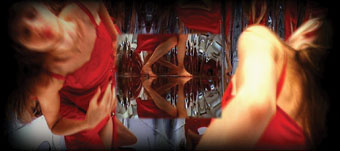The bridge: between iron and flesh
Mary Ann Hunter: Bonemap, Bridge Song

Bonemap, Bridge Song (projection still) Russell Milledge
Wearing a frock and stilettos, a woman is upturned. Over time, and to the discordant strains of a melodica, she rights herself and totters spasmodically across the space. It’s a disturbing image and an uncomfortable adjunct to the onscreen vision of a nocturnal bridge, silent headlights gliding along its embedded carriageway. Uneasy relations between iron and flesh, motorcar and mind, industry and humanity.
Bonemap’s Bridge Song aims to explore “the interrelationships of environment and moment within the precinct of [Brisbane’s] Story Bridge” and further attempts to extrapolate these to our wider understandings of being in the world. With an impressive array of collaborations and residencies to its name—including the first interdisciplinary Asialink residency in Singapore—Bonemap seeks to investigate interconnectedness through live art, installation and new media. Northern Queensland-based Bonemap’s creators, production designer/director Russell Milledge and choreographer/performer Rebecca Youdell, often work closely with other artists to produce “creative intermedia” with an ecological sensibility at the core. In Bridge Song, Milledge and Youdell partner with musicians Erik Griswold and Vanessa Tomlinson of Clocked Out Duo to create a series of “out-of-awareness” perceptions of time and place in a hybrid investigation of “daily life, flesh, earth and weather” using Brisbane’s Story Bridge as a focus.
The Story Bridge is an interesting choice. It is an urban icon linking South and North, attracting the tourist gaze, and sheltering a pretty good pub. While serviceable to pedestrians, it certainly hasn’t the popular foot traffic of bridges that link the CBD to South Bank, nor does it have the political capital of the William Jolly along which many a protester has marched en route to Musgrave Park. But in Bridge Song, the Story Bridge never looked so aesthetically intriguing, even if the wider metaphor of the importance of bridges in our fragile global ecology didn’t quite achieve the intended impact in this preview performance.
The work comprises 11 titled ‘responses’ to the bridge in which meaning is constructed and communicated through “a synthesis of mediated signs and sonic events.” In some episodes, this synthesis is achieved with creative clarity. In “Bridging the Gap”, 2 ropes tied at each end to drumsticks played by Griswold and Tomlinson on opposite sides of the stage provide a percussive literalisation of sound waves. As the drum rumblings evoke the splendid thunder of a Brisbane storm, the moving rope simultaneously creates an ephemeral canvas for the projected images of the river in flash flood. Equally evocative is the bird song created by the rubbing of Chinese ceramic bowls filled with water in “Edge of the Abyss.” In an inspired fusion of sound, image and movement Youdell inches her way across the space, tautly en pointe, while Milledge’s accompanying projection is meditative, animated with birds in time-lapse flight moving across the bridge’s webbed span. Episodes such as these provide a seamless merging of projected, corporeal and sound media, achieving the kind of synthesis Bonemap clearly aims for.
In the effort to transplant broader metaphorical resonances into these responses, Bridge Song sometimes loses its allure. For instance, the screen footage of a bridge warping and waving in an earthquake provides a stunning mirroring of built form with the natural kinaesthetic of flowing water. But as Youdell throws herself into a maelstrom of balletic movements in light of these astounding images, the synergy of body/projection loses impact. As she halts and exaggeratedly gasps for breath, it feels curiously disengaging. Then again, how can one begin to engage with the scale of such a powerful force? Later, in “Humanity”, the dancing body speaks for the first time: “I believe that the planet and humanity is unsustainable. …Now… now… now”. The statement is central to Bonemap’s philosophy yet, in this scene, fails to find a tension to equal its urgency. This section will undoubtedly become tighter in subsequent performances but, in terms of “extending the potential layers of audience empathy and engagement”, these broader parameters don’t quite arrest attention.
Many moments teeter on the edge of humour. At one point Tomlinson unexpectedly grabs Youdell’s leg in a flurry of percussion. And, as a static cartoon-like image, “Globe head” is intriguing with its social comment (a naked body sits contemplatively with a bleeding world globe substituting as an oversized head). But, for such a striking pose, it lacks a little of the irony or perhaps self-reflexivity needed to draw together this show’s ambitious amalgamation of the spatial, social, aesthetic and ecological.
In its first public outing, Bridge Song effectively spirited an interconnectedness between “moment and environment” with the specific iconography of the Story Bridge. And while the work’s conceptual global/personal divide is yet to be ‘bridged’ as seamlessly as its excellent production values, audiences can look forward to this work’s sustainable life.
Bridge Song, Bonemap in association with The Judith Wright Centre of Contemporary Arts, production design Russell Milledge, performer Rebecca Youdell, music Erik Griswold and Vanessa Tomlinson, Brisbane, June 12-14
RealTime issue #56 Aug-Sept 2003 pg. 7-8






